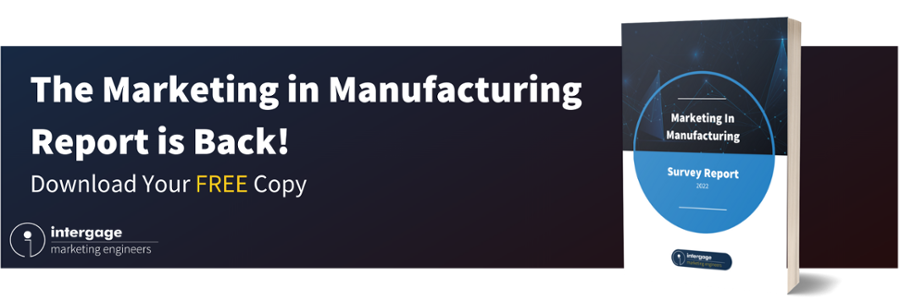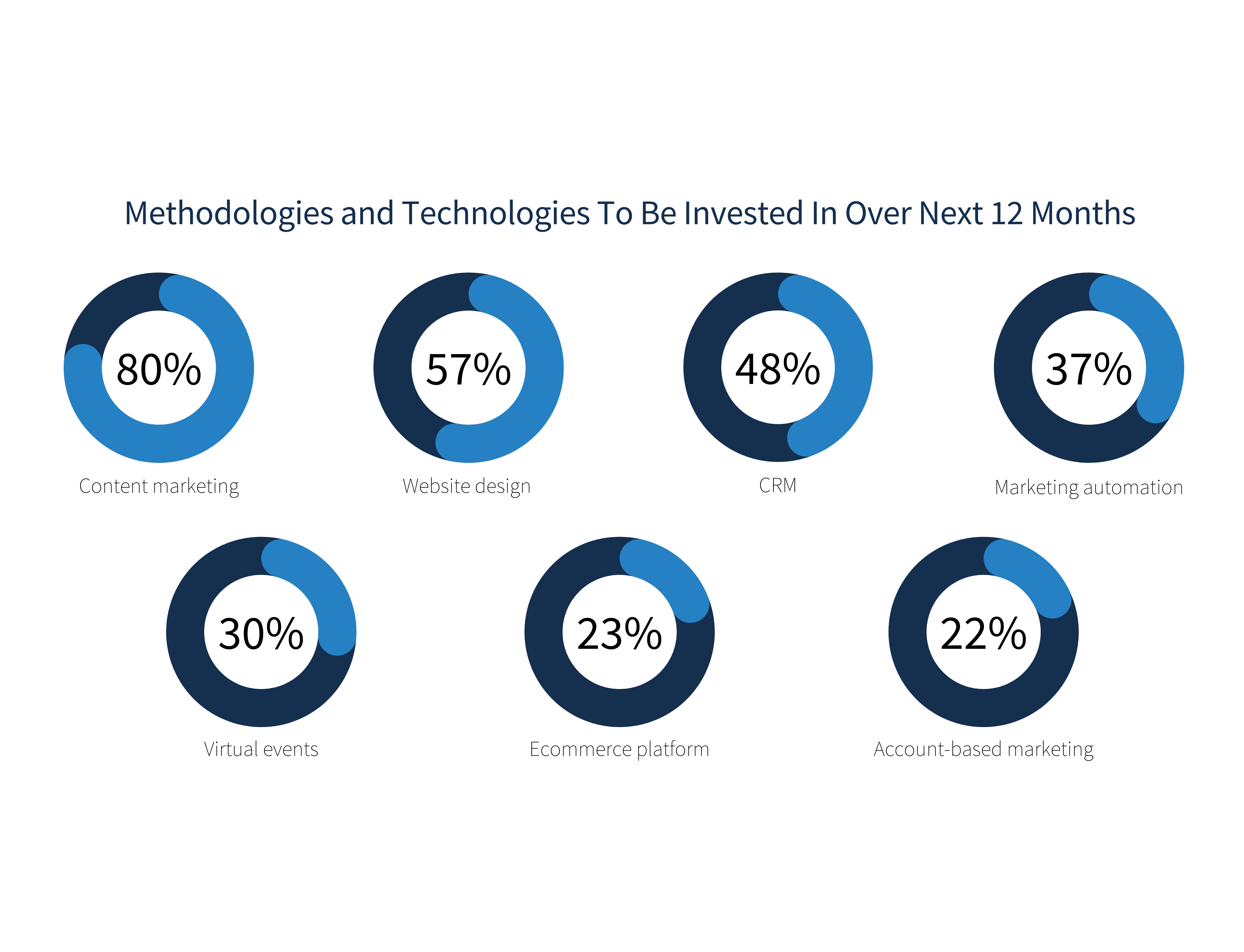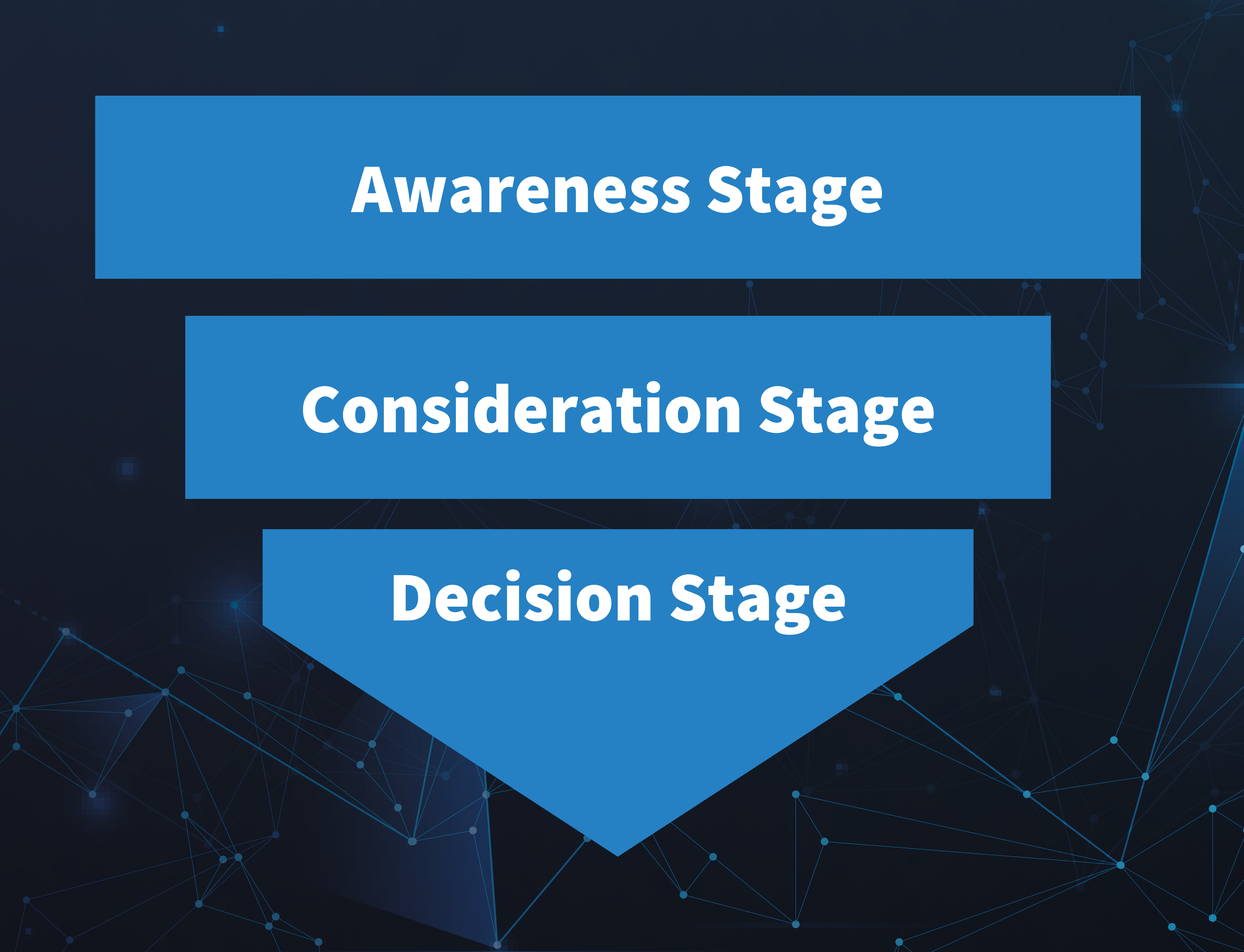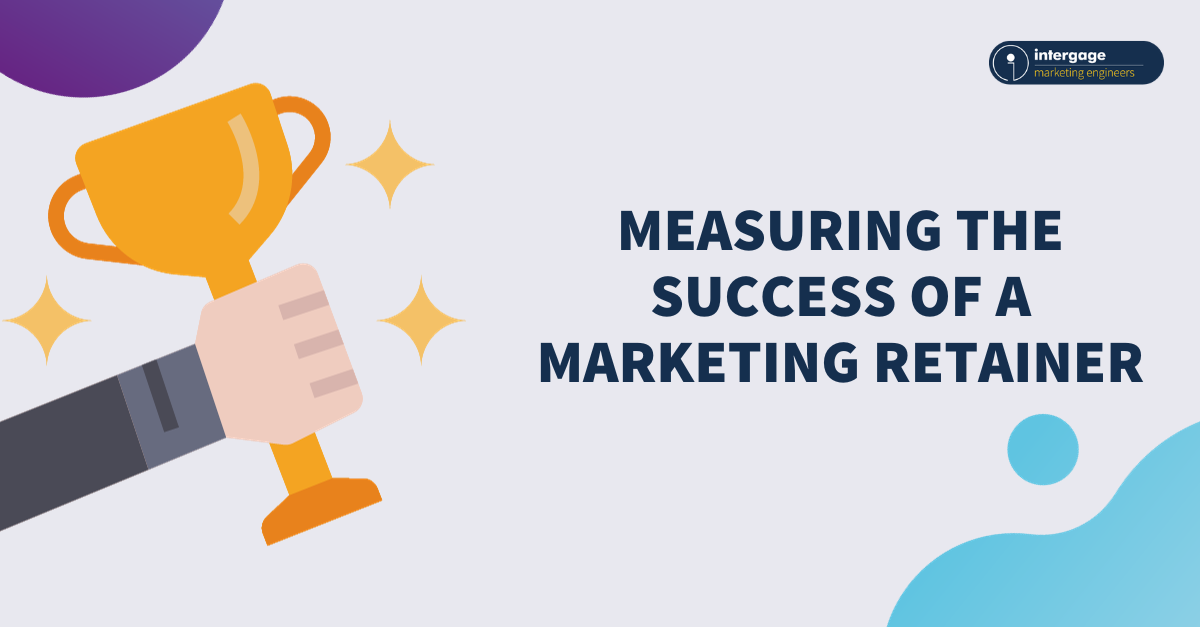Which Marketing Activities Should Manufacturers Invest In?
As a manufacturer battling challenging economic conditions and a global pandemic, you need to spend your marketing budget wisely.
This blog post will show:
- how your fellow manufacturing businesses are investing in marketing
- what that means for you
- what you should do next.
It’s based on a survey of UK manufacturing, engineering and industrial companies by Intergage and The Manufacturer. These are the valuable insights the data revealed…
Digital Vs Traditional Marketing
What We Found:
- 62% of respondents invested most of their marketing budget in digital initiatives.
- 13% did most of their marketing offline.
- 3% did no digital marketing at all.
What It Means:
It’s no surprise that digital marketing has been so popular over the last year: Covid-19 lockdowns put paid to exhibitions and other traditional face-to-face marketing events. The coronavirus pandemic has been a chilling wake-up call for those who still relied heavily on old-school networking for their leads.
But it’s worrying that 13% are still spending most of their marketing budget on less accountable offline tactics…and incredible that 3% are doing no digital marketing whatsoever. And all this at a time when Return On Investment (ROI) has never been more important.
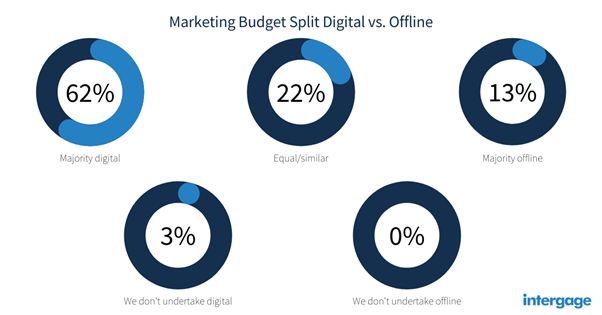
Consider this: just 17% of the B2B buyer journey is spent meeting with potential suppliers, a recent Gartner survey suggests.
But simply having a website is no longer enough. Engineers and manufacturers need joined-up, multi-channel campaigns to succeed in this competitive marketplace.
Marketing Activities: Organic Social Media
What We Found:
- 83% said posting organic content on social media was one of their top three marketing activities over the last 12 months.
What It Means:
Manufacturing – like other industries – has been seduced by the power and ubiquity of social media. At headline level, its global reach sounds very attractive. After all, there are 3.96 billion active social media users today (Backlinko)…at least half the world’s population. So what’s not to like?
Sadly, your organic reach is only as good as the content you share.
That’s because the social media giants’ ever-tougher algorithms are making it harder for people to see your free organic posts. LinkedIn, Facebook et al would much rather you advertised with them to reach your audience(s).
And with more and more engineering and manufacturing businesses upping their social media game, this digital space has become very crowded. So you have to work hard to stand out from the crowd.
You can’t ignore social media. Today’s empowered buyers are very ‘social-savvy’. They expect you to ‘do social’…and do it well.
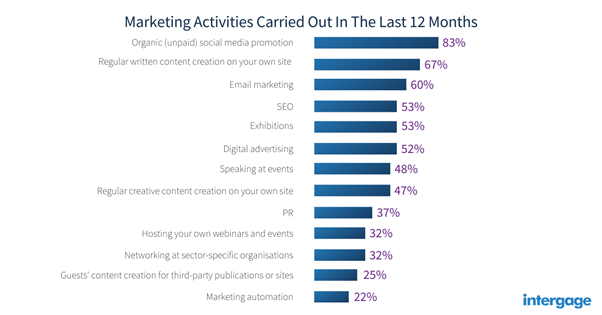
Marketing Activities: Content Marketing
What We Found:
- 67% of industrial companies invested in content marketing over the last 12 months.
What It Means
The Rise Of Outsourced Content Marketing
Yes, manufacturers are investing in content marketing. And they’re doing so because it works. But most are having to outsource it because:
- They don’t have the time or inclination to generate the very large amounts of content needed.
- Creating compelling text, imagery and video that nurtures leads and prompts them to engage and buy – rather than just skim and browse – is a highly specialised skill.
- Context is as important as content – you need to target each type of buyer at every stage of their buying journey (“right message, right person, right time”). That means generating a lot of content.
90% of B2B manufacturing companies that outsource marketing services are doing so because they need help to create content, according to a recent study by the Content Marketing Institute.
Why ‘Churn And Hope’ Won’t Work
Bottom line? Manufacturers who need content rely on agencies who truly understand the complex industrial marketplace and the needs within it.
Trouble is, the CMI report found that 50% of respondents focused on top-of-funnel marketing…with the latter stages receiving much less attention.
In reality, creating marketing material for each buyer at every stage of their journey is the most effective way to show them value and keep them coming back for more.
Why Guest Authoring Doesn’t Work For Most…But Works For The Smart Few
The marketing activity that saw the least positive response in our study was guests’ content creation for third-party websites or publications. Industrial businesses rarely create content for other publications – or they see limited results from guest blogging/features/articles.
This calls into question the industry’s ability or motivation to partner with the right websites and target the correct audiences.
But there’s a lot to be said for this type of marketing when it’s done well. Partnering with publications or third-party sites requires a lot of audience research – as well as a deep understanding of your own target personas.
Sales and Marketing Divide
What We Found:
- 45% of marketers said SEO was their most successful marketing activity
- 0% of salespeople named SEO as their most successful marketing activity
- 43% of salespeople said exhibitions and guests content creation for third party publications were their most successful marketing activities.
What It Means:
SEO is the gift that keeps on giving because it’s scalable. Your efforts will continue to reward you with quality leads while you’re working on something else.
But while 45% of marketers know this, this message isn’t getting through to their sales counterparts (or the other 55% of marketers, for that matter). And it highlights a huge disconnect between the marketing and sales departments.
Sales staff seem to place more emphasis and importance on traditional marketing activities, showing little desire for a more digital process.
That would have been a concern before Covid19 – but 18 months into the global pandemic, it’s a major worry. Sales and marketing need to get on the same page when it comes to digital.
Empowered Buyers Don’t Like Being ‘Sold To’
Today, fewer B2B buyers want to speak with a salesperson. They certainly don’t want to receive a cold call or spam email. Instead, they go online to answer questions that previously a salesperson would have handled.
This – whether you like it or not – is the reality in a brave new world dominated by empowered buyers. Targeting them requires subtlety, finesse and a confident command of the latest digital technology. Digitalisation offers undeniable advantages, such as:
- understanding your user’s behaviour through data collection and analysis
- timely and effective lead nurturing through marketing automation.
Learn more about why traditional lead generation is becoming less effective (and what you can do about it) in our Sales Production Line: Lead Generation for Engineers and Manufacturers white paper.
Marketing In The Next 12 Months: Where Should I Invest?
What We Found:
- 80% of respondents will invest in content marketing.
- 57% will invest in website design.
- 48% will invest in their Customer Relationship Management (CRM) system.
- 22% will invest in account-based marketing.
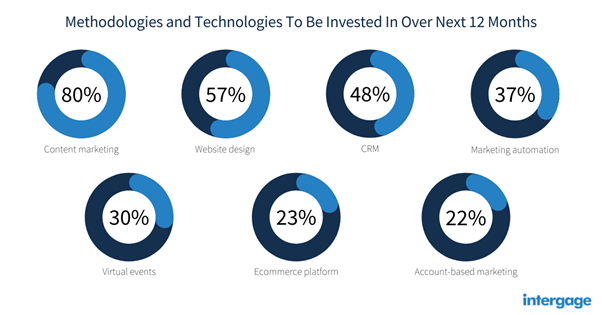
What It Means:
Content Is King…But Only With The Consent Of Its Consumers
Content marketing was the clear winner here. But that means the battle for users’ attention will get even tougher as more players join the fray. Laser-targeted and compelling copywriting will be more important than ever.
Your blog posts won’t get found or read if Google doesn’t like the quality of your website.
Your content must be valuable enough for users to cross the anonymity threshold and give you their details. You need to look long and hard at your conversion rates. Conversion rate optimisation should become your new obsession.
Web Design Is The Power Behind The Throne
Content marketing won’t work without good web design – hence why 57% of respondents named this a priority for 2021/22. And rightly so – a recent study by Gartner showed that 77% of respondents said their B2B purchase was very complex.
Improving website design and performance is vital if you are to eliminate any technical barriers that could impede or halt users’ progress through the buyer’s journey.
Some 88% of users are unlikely to return to a site after just one bad experience (source: Toptal). It’s crucial to understand how navigation, ease of use, messaging, tone of voice, design layout and technical performance affect your site’s ability to convert traffic into leads.
Equally crucial is having a good Customer Relationship Management (CRM) system...
Knowledge Is Power, Invest In Your CRM
As you have read, context is as important as content. Your ideal buyer must see your persuasive messages at the time that is best for them.
It’s not about you and your sales targets (as important as they are): it’s all about your buyers. They will consume content and buy at their own pace. Try to rush them and you will lose them. Today’s empowered buyers will walk away from anything that whiffs of outdated 20th century hard sell.
You need to know precisely how they’re feeling during each stage of the buyer’s journey. That means having a good CRM. It will help you to:
- see how well your content was consumed
- measure conversion rates for content, landing pages and call-to-action buttons/graphics
- gauge individual users’ levels of interest in your products and services
- identify ‘buy signals’
- nurture promising marketing-qualified leads and sales-qualified leads
- pick exactly the right time to close the sale.
Account-Based Marketing
Did you notice that only 22% of manufacturers planned to invest in account-based marketing? These are the smart ones who’re ahead of the curve.
Account-based marketing is like being a sniper. You’re not spraying bullets in the hope that some might hit a few targets. You’re focussing on your quarry and hunting them.
Your marketing and sales teams work together to target best-fit accounts and turn them into customers.
This is particularly important for manufacturers in niche sub-sectors where online search volumes are likely to be low. It’s also extremely good for ROI.
Download The Full Report
Want to know more about marketing in the industrial sectors and where you should be focusing your time and money for success? Download the full Marketing In Manufacturing Report here!
Further Reading: Manufacturing Marketing Intelligence
- Building Marketing Personas For Manufacturers. Read more…
- How Do Engineers And Manufacturers Measure Marketing Success? Read more…
- Key Digital Marketing Stats Your Manufacturing Business Should Measure. Read more…
